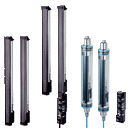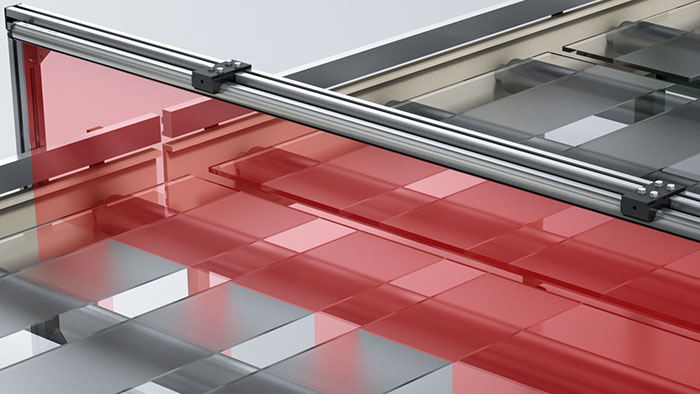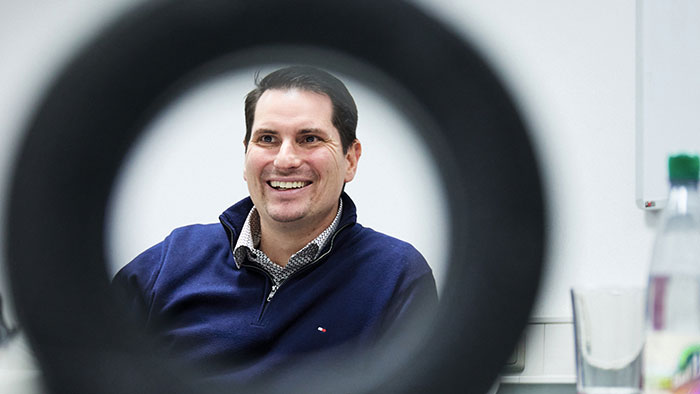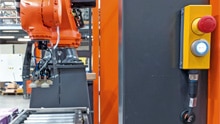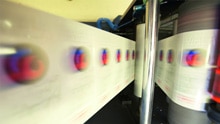It’s a Friday morning in mid-January 2024. The place: the large assembly hall at the mechanical engineering company Karl Eugen Fischer GmbH in Burgkunstadt, Upper Franconia. Today, roughly a week before delivery to the customer, the world’s leading manufacturer of cord cutting lines for tire manufacturing will put one of the lines through its paces – and we get to be there live to report on it with texts, images and videos. After all, we’re talking about a very special machine that, thanks to the installation of a solution from SICK, is taking the performance of these lines to the next level.
The MLG-2 WebChecker from SICK is taking cord cutting lines in tire manufacturing to the next level
Achim Sorg, Lead Account Manager Automotive & Electronics SICK Vertriebs GmbH, and Jörg Weiser, Application Engineer Automotive & Electronic SICK Vertriebs GmbH, have also come to visit their customer KE Fischer today: the two sales experts are the people who first had the idea of applying the SICK solution to this type of line. Together with Frank Schmidt, Head of Software, Electric Engineering & R&D at KE Fischer, and his team, they’ve now made that idea a reality.
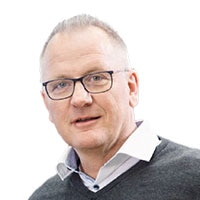
Even tires have belts
Our path leads us through the massive hall to a brand spanking new freshly painted, approx. 40-meter-long cord cutting machine, which is already running in test mode and being closely monitored by several KE Fischer staff. The room smells like metal and tire rubber.
First of all, Frank Schmidt explains what the machine actually does: the line cuts what is known as steel cord calender. This is the rubber-coated steel wire that is needed for the “belts” in tires. Within the line, steel cord is fed from a several-meter-long roll. A huge knife cuts the material, which is fed in at an angle, into individual strips. Depending on the formula, the cutting angle can be adjusted by semi-automatically moving the components used to feed the steel cord on rails built into the floor.
The system now joins these strips, which have been cut at an angle, back together to form an endless strip and then slits this once again into two individual strips. This results in several new spools of steel cord material in which the steel wires run at an angle – which is important for tire stability, as Frank Schmidt explains: “In the next stage of processing for tire manufacturing, multiple layers containing steel and textile cord are combined. That means the cord cutting machine needs to prepare these strips as precisely as possible – so an extremely precise, high-performance edge guiding solution and inline quality monitoring for the material are essential.”
Perspective on digitalization
And where exactly is the innovation built into the line? To answer that, Frank Schmidt has to give us some background information first: until recently, the standard solution in this type of line for measuring the material’s width and ensuring correct feeding on a specific track consisted of a CCD line scan camera together with an actuator, a regulator, and further components. But this approach had a number of disadvantages: “These solutions have to be painstakingly calibrated to ensure that all the material widths we need can be processed by the line,” says Schmidt. Moreover: they’re very high maintenance and in most cases, users can’t make repairs themselves. If the solutions have to be replaced, it means downtime, since the new camera has to be carefully parametrized and calibrated before it can be used.
Achim Sorg had the idea of replacing this impractical “black box” solution with the MLG-2 WebChecker from SICK back in 2020. The automation light grid uses multiple photoelectric proximity sensors, arranged at regular intervals, to precisely measure web width. “This step is a prime example of how we at SICK approach our customers with solutions they’d never considered before,” says Achim Sorg. He and Jörg Weiser, who had years of experience in the tire manufacturing industry, prepared the proposal – which Frank Schmidt welcomed with open arms; he had long-since detemined that the line scan camera solution was fragile and high maintenance. “The solution was simply outdated – plus, it offered no prospects for digitalization,” he explains. “I wanted to change that, and the MLG-2 WebChecker was predestined for the job.”
SICK and KE Fischer launched a pilot project to assess the idea’s feasibility – with a positive outcome: In 2021, KE Fischer became the world’s first cord cutting line manufacturer to equip its lines with the MLG-2 WebChecker – initially at just one point in the line, followed by more and more. “In fact, we initially installed the MLG-2 WebChecker at our own expense to give our customers a chance to try out the solution, so that they could make an informed decision about using it,” Frank Schmidt recalls. At SICK’s request, the MLG-2 WebChecker was further adjusted to better meet KE Fischer’s specific needs. And the hard work paid off: Today, more than 20 lines at KE Fischer’s customers include the MLG-2 WebChecker.
Perfect quality management tool
The line we’re looking at today includes no fewer than seven MLG-2 WebChecker. Frank Schmidt takes us along the entire length of the line. The devices continually measure the width of the steel cord web and check, down to the nearest tenth of a millimeter, whether it is within tolerance. If they determine that it isn’t, the line autonomously adjusts, within a certain tolerance limit per servo, until the correct width is reached.
“It’s the perfect quality management tool for the entire production process,” says Schmidt. In addition, the system is highly flexible: the MLG-2 WebChecker can measure web widths of between 145 mm and 3,150 mm. This flexibility makes changing formats child’s play – with no need for downtimes.
To show us how this works, the operators vary the width of the strips that are cut from the roll. “No matter whether the material is centered or staggered, or if there are two webs running in parallel on the line – you can set the MLG-2 WebChecker for it all. In fact, it can measure up to five webs at once,” says Schmidt.
But for Frank Schmidt, the MLG-2 WebChecker is above all an important step forward with regard to digitalization: valuable insights can be gained from the data that the light grid generates. The open source basis and fundamental software building blocks were provided by SICK, while KE Fischer developed its own building blocks for the specific application: “Our algorithms intelligently assess the data and prepare analyses that are available to operators, maintenance and quality control staff in real-time,” says Frank Schmidt.
Using a tablet, he shows us what this looks like. “For instance, this data can offer insights into maintenance and quality: Where are there problems or room for improvement? What does the web’s quality look like – in the upstream production process and here on this line? Our solution makes “invisible” data visible, a clear added value for customers."
Generally speaking, KE Fischer’s goal is to make its lines as easy to operate as possible: “‘Hands off, eyes off’ in the sense of an autonomous machine is our goal. And with the WebChecker, we’ve come one major step closer to achieving it,” says Schmidt.
Generally speaking, KE Fischer’s goal is to make its lines as easy to operate as possible: “‘Hands off, eyes off’ in the sense of an autonomous machine is our goal. And with the WebChecker, we’ve come one major step closer to achieving it,” says Schmidt.
The three men agree: the MLG-2 WebChecker has the potential to become a new trendsetter for edge guiding and as a measuring system in tire production. “Frank Schmidt has paved the way for that to happen,” says Achim Sorg. Throughout the collaboration, both parties have contributed to steadily improving the solution. Accordingly, Frank Schmidt has nothing but good things to say about the customer service at SICK: “That’s where SICK clearly stands out from the competition. Achim and Jörg always had time for us and accommodated all our needs and preferences – until we arrived at a solution that was a perfect fit.”
It’s now afternoon, and the assembly hall is nearly empty. Today’s test run is over, and we’ve got all the material we needed “in the bag.” In the weeks to come, Frank Schmidt and his team will make a few last adjustments. After that, the line will be sent to the customer – where all its benefits can be put to best use.
Karl Eugen Fischer GmbH
Karl Eugen Fischer GmbH is the global market leader for steel and textile cord cutting lines, which are essential to the manufacture of tires for motorcycles, passenger cars, SUVs, trucks and offroad vehicles. Founded in 1940, its headquarters and main production facilities are in Burgkunstadt, Germany. The company operates subsidiaries in the USA, China and – following the acquisition of Konštrukta TireTech (KTT), a manufacturer of extrusion and cutting lines for the tire industry, in December 2022 – in Slovakia. Now home to more than 600 employees, over the past 50 years KE Fischer has delivered more than 900 cutting lines to customers in 50 countries around the globe.
Pace: Magazine from the 2023 Annual Report
The highly dynamic nature of the markets and technological progress require solutions to be found at an accelerated pace. We are constantly adapting our speed in order to gain and maintain a competitive edge by using our accelerating powers sensibly.
The articles in the magazine show that those who gain a head start and time through speed can use it intelligently for new ideas and sustainable decisions.


